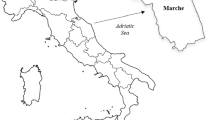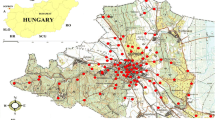Abstract
Changes in the soil chemical environment can be expected to increase the leaching of trace metals bound in soils. In this study the mobility of trace metals was monitored in a column experiment for two contaminated urban soils. Four different treatments were used (i.e. rain, acid rain, salt and bark). Leachates were analysed for pH, dissolved organic carbon (DOC) and for seven trace metals (cadmium (Cd), chromium (Cr), copper (Cu), mercury (Hg), nickel (Ni), lead (Pb) and zinc (Zn)). The salt treatment produced the lowest pH values (between 5 and 6) in the effluent whereas the DOC concentration was largest in the bark treatment (40–140 mg L−1) and smallest in the salt and acid treatments (7–40 mg L−1). Cadmium, Ni and Zn were mainly mobilised in the salt treatment, whereas the bark treatments produced the highest concentrations of Cu and Pb. The concentrations of Cu, Cr, and Hg were strongly correlated with DOC (r 2 = 0.90, 0.91 and 0.96, respectively). A multi-surface geochemical model (SHM-DLM) produced values for metal dissolution that were usually of the correct magnitude. For Pb, however, the model was not successful indicating that the retention of this metal was stronger than assumed in the model. For all metals, the SHM-DLM model predicted that soil organic matter was the most important sorbent, although for Pb and Cr(III) ferrihydrite was also important and accounted for between 15 and 50% of the binding. The results confirm the central role of DOC for the mobilization of Cu, Cr, Hg and Pb in contaminated soils.





Similar content being viewed by others
References
Aastrup, M., & Thunholm, B. (2001). Heavy metals in Stockholm groundwater-concentrations and fluxes. Water, Air, & Soil Pollution Focus, 1(3–4), 25–41.
Alexandersson, H., Karlström, C., & Larsson-McCann, S. (1991). Temperature and precipitation in Sweden 1961–1990. Meterologi nr 81, 88 p. Norrköping, Sweden: SMHI (in Swedish with English summary).
Anderson, P., Davidson, C. M., Duncan, A. L., Littlejohn, D., Ure, A. M., & Garden, L. M. (2000). Column leaching and sorption experiments to assess the mobility of potentially toxic elements in industrially contaminated land. Journal of Environmental Monitoring, 2, 234–239.
Bäckström, M., Karlsson, S., Bäckman, L., Folkesson, L., & Lind, B. (2004). Mobilisation of heavy metals by deicing salts in a roadside environment. Water Research, 38, 720–732.
Bäckström, M., Nilsson, U., Håkansson, K., Allard, B., & Karlsson, S. (2003). Speciation of heavy metals in road runoff and roadside total deposition. Water, Air and Soil Pollution, 147, 343–366.
Berggren, D. (1990). Species of Al, Cd and Cu in forest soil solutions analytical methods, mobilization mechanisms, and toxicity to plants, Ph.D. Thesis, Department of Ecology, Plant Ecology, Lund University, Lund.
Bloom, N. S., & Fitzgerald, W. F. (1988). Determination of volatile mercury species at the picogram level by low-temperature gas chromatography with cold vapour atomic fluorescence detection. Analytica Chimica Acta, 208, 151–161.
Burghardt, W. (2002, August). Peculiarities of soil structure in urban, industrial and mining areas and their effects on soil functions, Symposium no.55, Paper no. 1535 (Paper presented at the 17th World Congress of Soil Science).
Chen, T. B., Wong, J. W. C., Zhou, H. Y., & Wong, M. H. (1997). Assessment of trace metal distribution and contamination in surface soils of Hong Kong. Environmental Pollution, 95, 61–68.
de Miquel, E., Llamas, J. F., Chacón, E., Berg, T., Larssen, S., Royset, O., et al. (1997). Origin and patterns of distribution of trace elements in street dust unleaded petrol and urban lead. Atmospheric Environment, 31, 2733–2740.
Dijkstra, J. J., Meeussen, J. C. L., & Comans, R. N. J. (2004). Leaching of heavy metals from contaminated soils: An experimental and modeling study. Environmental Science and Technology, 38, 4390–4395.
Dijkstra, J. J., van der Slot, H. A., Spanka, G., & Thielen, G. (2005). How to judge release of dangerous substances from construction products to soil and groundwater CPD Topic 1 – Soil and groundwater impact. ECN report number ECN-C-05-045. Energy research Centre of the Netherlands (ECN). Petten, The Netherlands 72 p.
Dzombak, D. A., & Morel, F. M. M. (1990). Surface complexation modeling. Hydrous ferric oxide. New York: Wiley.
Elert, M., Fanger, G., Höglund, L.-O., & Jones C. (2006). Laktester för riskbedömning av förorenade områden. Rapport 5535 83 p. Stockholm, Sweden: Naturvårdsverket.
Eriksson, J., Andersson, A., & Andersson, R. (1997). Current status of Swedish arable soil. Rapport 4778 59 p. Stockholm, Sweden: Naturvårdsverket (in Swedish with English summary).
Fitzgerald, W. F., & Gill, G. A. (1979). Subnanogram determination of mercury by two-stage gold amalgamation and gas phase detection applied to atmospheric analysis. Analytical Chemistry, 51, 1714–1720.
Fukushima, M., Nakayasu, K., Tanaka, S., & Nakamura, H. (1995). Chromium(III) binding abilities of humic acids. Analytica Chimica Acta, 317, 195–206.
Gustafsson, J. P. (2001). Modeling the acid-base properties and metal complexation of humic substances with the Stockholm model. Journal of Colloid and Interface Science, 244, 102–112.
Gustafsson, J. P. (2006). Visual MINTEQ, version 2.51. Retrieved December 27, 2006, from Royal Institute of Technology, Department of Land and Water Resources Engineering Web site: http://www.lwr.kth.se/english/OurSoftWare/Vminteq/index.htm.
Gustafsson, J. P., & Berggren Kleja, D. (2005). Modeling salt-dependent proton binding by organic soils with the NICA-Donnan and Stockholm humic models. Environmental Science and Technology, 39, 5372–5377.
Gustafsson, J. P., & van Schaik, J. W. J. (2003). Cation binding in a mor layer: Batch experiments and modelling. European Journal of Soil Science, 54, 295–310.
Gustafsson, J. P., Bhattacharya, P., Bain, D. C., Fraser, A. R., & McHardy, W. J. (1995). Podzolisation mechanisms and the synthesis of imogolite in northern Scandinavia. Geoderma, 66, 167–184.
Gustafsson, J. P., Pechová, P., & Berggren, D. (2003). Modeling metal binding to soils: The role of natural organic matter. Environmental Science and Technology, 37, 2767–2774.
Gustafsson, J. P., Persson, I., Berggren Kleja, D., & van Schaik, J. W. J. (2007). Binding of iron(III) to organic soils EXAFS spectroscopy and chemical equilibrium modeling. Environmental Science and Technology (in press).
Hursthouse, A., Tognarelli, D., Tucker, P., Ajmone Marsan, F., Martini, C., Mardid, L., et al. (2004). Metal content of surface soils in parks and allotments from three European cities initial pilot study results. Land Contamination and Reclamation, 12, 189–196.
Kelly, J., Thornton, I., & Simpson, P. R. (1996). Urban geochemistry a study of the influence of anthropogenic activity on heavy metal content of soils in traditionally industrial and non-industrial areas of Britain. Applied Geochemistry, 11, 363–370.
Linde, M., Bengtsson, H., & Öborn, I. (2001). Concentrations and pools of heavy metals in urban soils in Stockholm, Sweden. Water, Air, & Soil Pollution Focus, 1(3–4), 83–101.
Madrid, L., Díaz-Barrientos, E., Reinoso, R., & Madrid, F. (2004). Metals in urban soils of Seville seasonal changes and relations with other soil components and plant contents. European Journal of Soil Science, 55, 209–217.
Miljöförvaltningen. (1994). Vattenprogram för Stockholm – Sjöar och vattendrag. Programperiod 1994–1998. Stockholm, Sweden: Miljöförvaltningen, Stadsbyggnadskontoret, Stockholm Vatten AB, Gatu-och fastighetskontoret (in Swedish).
Miljöförvaltningen. (1997). Grundvatten i Stockholm-tillgång, sårbarhet, kvalitet. Stockholm, Sweden: Miljöförvaltningen i Stockholm December 1997 (in Swedish).
Naturvårdsverket. (1997). Development of generic guideline values, report 4639. Stockholm, Sweden: Swedish Environmental Protection Agency.
Norrström, A. C., & Jacks, G. (1998). Concentration and fraction of heavy metals in roadside soils receiving de-icing salts. Science of the Total Environment, 218, 161–174.
Öborn, I., & Linde, M. (2001). Solubility and potential mobility of heavy metals in two contaminated urban soils from Stockholm, Sweden. Water, Air, & Soil Pollution Focus, 1(3–4), 255–265.
Paterson, E., Sanka, M., & Clark, L. (1996). Urban soils as pollutant sinks – A case study from Aberdeen, Scotland. Applied Geochemistry, 11, 129–131.
Peltola, P., & Åström, M. (2003). Urban geochemistry: A multimedia and multielement survey of a small town in Northern Europe. Environmental Geochemistry and Health, 25, 397–419.
Pichtel, J., Sawyer, H. T., & Czarnowska, K. (1997). Spatial and temporal distribution of metals in soils in Warsaw, Poland. Environmental Pollution, 98, 169–174.
Pueyo, M., Sastre, J., Hernández, E., Vidal, M., López-Sánchez, J. F., & Rauret, G. (2003). Prediction of trace metal element mobility in contaminated soils by sequential extraction. Journal of Environmental Quality, 32, 2054–2066.
Ross, S. (1994). Retention, transformation and mobility of toxic metals in soils. In S. Ross (Ed.), Toxic metals in soil-plant systems (pp. 63–152). Chichester: Wiley.
Sohlenius, G., & Öborn, I. (2004). Geochemistry and partitioning of trace metals in acid sulphate soils in Sweden and Finland before and after sulphidic oxidation. Geoderma, 122, 167–175.
Swedish Standards Institute. (1997a). Soil analysis – Determination of trace elements in soils-extraction with nitric acid. Swedish Standards Institute SS 02 83 11 (in Swedish).
Swedish Standards Institute. (1997b). Metal content of water, sludge and sediment determined by flameless atomic absorption spectrometry – Special guidelines for aluminium, lead, iron, cadmium, cobolt, copper, chromium, manganese and nickel. Svensk Standard SS 028184/T1. (in Swedish).
Swedish Standards Institute. (2005). Characterization of waste – Leaching behaviour tests – Influence of pH on leaching with initial acid/base addition. SIS-CEN/TS 144292005.
Tipping, E. (2002). Cation binding by humic substances. Cambridge environmental chemistry series 12. Cambridge: Cambridge University Press.
Weesner, F. J., & Bleam, W. F. (1998). Binding characteristics of Pb2+ on anion-modified and pristine hydrous oxide surfaces studied by electrophoretic mobility and X-ray absorption spectroscopy. Journal of Colloid and Interface Science, 205, 380–389.
Weng, L. P., Temminghoff, E. J. M., Lofts, S., Tipping, E., & van Riemsdijk, W. H. (2002). Complexation with dissolved organic matter and solubility control of heavy metals in a sandy soil. Environmental Science and Technology, 36, 4804–4810.
Weng, L. P., Temminghoff, E. J. M., & van Riemsdijk, W. H. (2001). Contribution of individual sorbents to the control of heavy metal activity in sandy soil. Environmental Science and Technology, 35, 4436–4443.
Wu, J., West, L. J., & Stewart, D. I. (2002). Efffect of humic substances on Cu(II) solubility in kaolin-sand soil. Journal of Hazardous Materials, B94, 223–238.
Acknowledgments
We would like to thank Kenth Andersson for carrying out the leaching extraction and Gunilla Lundberg for analysing the metals. The study was financially supported by the Swedish Environmental Protection Agency.
Author information
Authors and Affiliations
Corresponding author
Rights and permissions
About this article
Cite this article
Linde, M., Öborn, I. & Gustafsson, J.P. Effects of Changed Soil Conditions on the Mobility of Trace Metals in Moderately Contaminated Urban Soils. Water Air Soil Pollut 183, 69–83 (2007). https://doi.org/10.1007/s11270-007-9357-5
Received:
Accepted:
Published:
Issue Date:
DOI: https://doi.org/10.1007/s11270-007-9357-5




